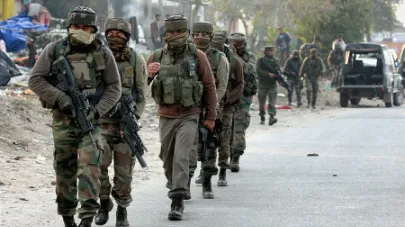The second encounter in Jammu since the erstwhile State’s reorganisation into Union Territory (UT) in August 2019 has preempted a possible tragedy ahead of Prime Minister Narendra Modi’s visit at the cost of the life of an Assistant Sub Inspector (ASI) of the Central Industrial Security Force (CISF) on Friday, 22 April. But, concurrently, for the common civilian population, it has brought back fears of the bloodshed Jammu witnessed for over two decades.
Working on specific information about the hiding of two foreigners in the Jalalabad neighbourhood of Sunjuwan, on the outskirts of the UT’s winter capital, Police and security forces launched an operation in the wee hours of 22 April. The holed-up militants opened fire and made unsuccessful attempts to escape. Both of them got killed in the armed retaliation.
Director General of Police, Dilbag Singh, and Additional DGP of Jammu, Mukesh Kumar, maintained that the guerrilla duo were the Pakistani cadres of Masood Azhar’s Jaish-e-Mohammad (JEM). They viewed the two terrorists’ presence in Jammu as part of a possible conspiracy to sabotage the Prime Minister’s scheduled visit on Sunday, 24 April. Three AK rifles, bulletproof vests, hand grenades, one satellite phone and energy drink containers were recovered from the site of the counter.
“The terrorists were tasked with a fidayeen attack on some security forces’ camp or convoy to inflict substantial casualties”, the DGP said. One ASI of CISF was killed and four personnel sustained injuries during the encounter. DGP ruled out the possibility of a direct attack on the PM’s rally at Palli Panchayat in Samba, 30 km from Jammu.
On the Panchayati Raj Diwas, PM is scheduled to address a one-lakh-strong rally of common people and members of the Panchayati Raj Institutions, on Sunday. He will be inaugurating several power and infrastructure projects including the already functional Banihal-Qazigund tunnel on the Jammu-Srinagar highway through virtual mode from Samba. This will be Prime Minister Modi’s first civilian and political visit to the UT of Jammu and Kashmir. His last political visit to the erstwhile State of Jammu and Kashmir was on April 14, 2019 when he addressed some election rallies in Kathua and Udhampur.
After becoming Prime Minister for his second term on May 30, 2019, the withdrawal of J&K’s special status and reorganisation into the two UTs on August 5 of that year, Modi visited Jammu on October 27 and November 4, 2021—both times to only celebrate Diwali with the troops in Rajouri district. His successful visit could be seen as a major setback to the Pakistani narrative of “irretrievable alienation” and “rejection of the abrogation of Article 370 by the Kashmiris”.
On 10 February 2018, Jaish-e-Mohammad’s Pakistani fidayeen conducted a major suicide attack on an Army camp at Sunjuwan. Six soldiers, one civilian and three terrorists died in that encounter.
Thereafter two encounters happened when the Police and security forces intercepted the Kashmir-bound vehicles of the Pakistani terrorists at Jhajjar Kotli on 12 September 2018 and at Ban Toll Plaza of Nagrota on 18 November 2020.
While three terrorists were killed and 12 security forces and Police personnel sustained injuries at Jhajjar Kotli, 4 Pakistani terrorists of Jash-e-Mohammad were killed at the Ban Toll Plaza. A huge quantity of arms and ammunition, including 11 AK rifles, 3 pistols and 29 grenades was recovered. It was the first major encounter in Jammu since the creation of the UT.
Much like Kashmir, Jammu witnessed a large number of suicide attacks, bomb blasts and encounters in the first 25 years of the insurgency. At the Republic Day parade in 1995, then Governor KV Krishna Rao had a providential escape in the serial bomb blasts at M.A. Stadium that claimed 8 lives. Most of these attacks and encounters occurred either in Jammu city or on the Jammu-Srinagar national highway from Kathua to Udhampur.
The deadliest terrorist attack on an army camp occurred on 14 May 2002 when 31 persons—3 soldiers, 18 family members of the army personnel and 10 civilians, along with three suicide attackers—got killed in the encounter at Kaluchak . Around 50 persons were injured.
Photojournalist Ashok Sodhi was among the 6 civilians, one soldier and two terrorists killed in an encounter at Kaili Mandi Samba on 9-10 May in 2008.
Also Read: Killing of Yusuf Kantroo, Kashmir longest surviving terrorist bolsters morale among security forces
Two identical attacks were carried out on the Police and Army installations at Samba/Hiranagar and Dayala Chak Kathua on 26 September 2013 and 28 March 2014 respectively. Six Policemen, three soldiers, including a Lieutenant Colonel, three civilians and three terrorists died in the first attack. One civilian driver, one army officer and three terrorists got killed at Dyala Chak.
In 2015, a similar attack occurred at Rajbagh Police Station in Kathua. On 5 August 2015, LeT terrorists attacked a BSF bus near Samroli, Udhampur. Two BSF men and a terrorist were killed. LeT’s most dreaded terrorist Naved Jhat, who later escaped from the Police custody at SMHS Hospital Srinagar in February 2018, was arrested in the same encounter.
In 2016, one CRPF man and one terrorist died during an attack at a paramilitary camp at Kud, Udhampur, on 12 June. Later, 9 soldiers, including 2 Majors, and 3 terrorists died in an encounter during a suicide strike on Army’s 166-Artillery camp at Nagrota on 29 November.
Thereafter the last terror attack happened at the army camp Sunjuwan on 10 February 2018. The encounters at Jhajjar Kotli (12 September 2018), Ban Toll Plaza Nagrota (18 November 2020) and Jalalabad Sunjuwan (22 April 2022) were initiated by the Jammu and Kashmir Police and the paramilitary forces.




















